Introduction to Humulene
Humulene, a naturally occurring terpene with an earthy, woody aroma, is a standout component in the world of aromatic compounds. Known for its presence in cannabis as well as in various other plants like hops and spices, humulene adds rich, herbal notes that enhance the sensory experience. This terpene is recognized for its unique aroma and its role in traditional practices, highlighting its broader significance in nature and industry.
Humulene in Cannabis
In cannabis, humulene contributes to the unique aroma profiles of certain strains, particularly those with earthy, spicy, and woody scents. It is part of the complex interplay of components that make up the "entourage effect"—a concept suggesting that the combined effects of cannabis's various compounds create a unique experience. Humulene is noted for adding depth to the flavor and aroma of cannabis, which can influence the preferences of cannabis users.
Humulene Beyond Cannabis
Beyond cannabis, humulene is abundant in other plants such as hops and cloves, each bringing its own unique benefits to different industries:

Hops in Brewing
One of the most well-known non-cannabis sources of humulene is hops, an essential ingredient in beer brewing. Humulene imparts a distinct bitterness and a complex, earthy aroma to many beers, especially in hop-forward styles like IPAs. Its role in brewing is not only about flavor but also about contributing to the beer's overall aromatic profile.
Cloves and Other Spices
Beyond hops, humulene is also found in cloves, where it adds to the spice's pungent and spicy aroma. In traditional applications, particularly in places where cloves are indigenous, the spice is used extensively in cooking and natural practices, valued for its robust scent and flavor.
Natural Sources Where Humulene's Present
- Hops: Often associated with the brewing of beer, hops are one of the most prominent sources of humulene, contributing to the beer's distinct aroma and flavor.
- Cannabis: Humulene contributes to the earthy, woody, and spicy aroma profile of certain cannabis strains.
- Sage: This herb contains humulene, which adds to its aromatic and potential therapeutic properties.
- Ginseng: The root is known for its herbal remedies, and humulene is one of its components.
- Black Pepper: Known for adding spiciness and warmth, black pepper also contains humulene.
- Clove: Used both as a spice and in traditional medicine, clove contains humulene, which contributes to its spicy aroma.
- Basil: Particularly in some varieties, basil emits a strong scent partly due to its humulene content.
- Ginger: The spicy and sharp aroma of ginger is also partly due to humulene.
- Sunflower: Humulene is found in the oil extracted from sunflower seeds.
- Wood: Various types of wood, including pine wood, emit humulene, contributing to their characteristic scents.
The Origins and History of Humulene
Humulene is a naturally occurring terpene that can be found in a diverse array of plants, including many herbs, spices, and flowers. The presence of humulene in these plants is believed to play a crucial role in their defense mechanisms, acting as a deterrent to herbivores and insects, while also potentially attracting beneficial pollinators.
The use of humulene-rich plants in traditional medicine and cultural practices can be traced back centuries, if not millennia. For example, the use of hops and cloves in various traditional medicine systems, such as Traditional Chinese Medicine and Ayurvedic medicine, may be attributed, in part, to their humulene content and the perceived therapeutic benefits associated with this versatile terpene.
The Future of Humulene
As the cannabis industry continues to evolve and consumers become increasingly discerning, the role of humulene and other terpenes in shaping the overall cannabis experience is likely to remain a topic of keen interest. Further research into the synergistic effects of humulene, in combination with cannabinoids and other terpenes, may uncover additional insights into its potential therapeutic applications.
Beyond the cannabis realm, the diverse sources and applications of humulene ensure that it will continue to be a valuable and widely used compound in various industries, from beer production to personal care and beyond. As consumer demand for natural, plant-derived ingredients grows, the significance of humulene and other terpenes in the marketplace is poised to expand, driving innovation and new product formulations.
Conclusion
Humulene is a captivating terpene that has made a significant impact in the cannabis industry and beyond. Its prevalence in a diverse array of plants, from cannabis to hops and cloves, underscores the versatility and importance of this remarkable molecule. As the understanding of humulene and its interactions continues to evolve, its significance in shaping the future of cannabis, as well as the broader landscape of plant-derived compounds, is likely to become increasingly prominent.














